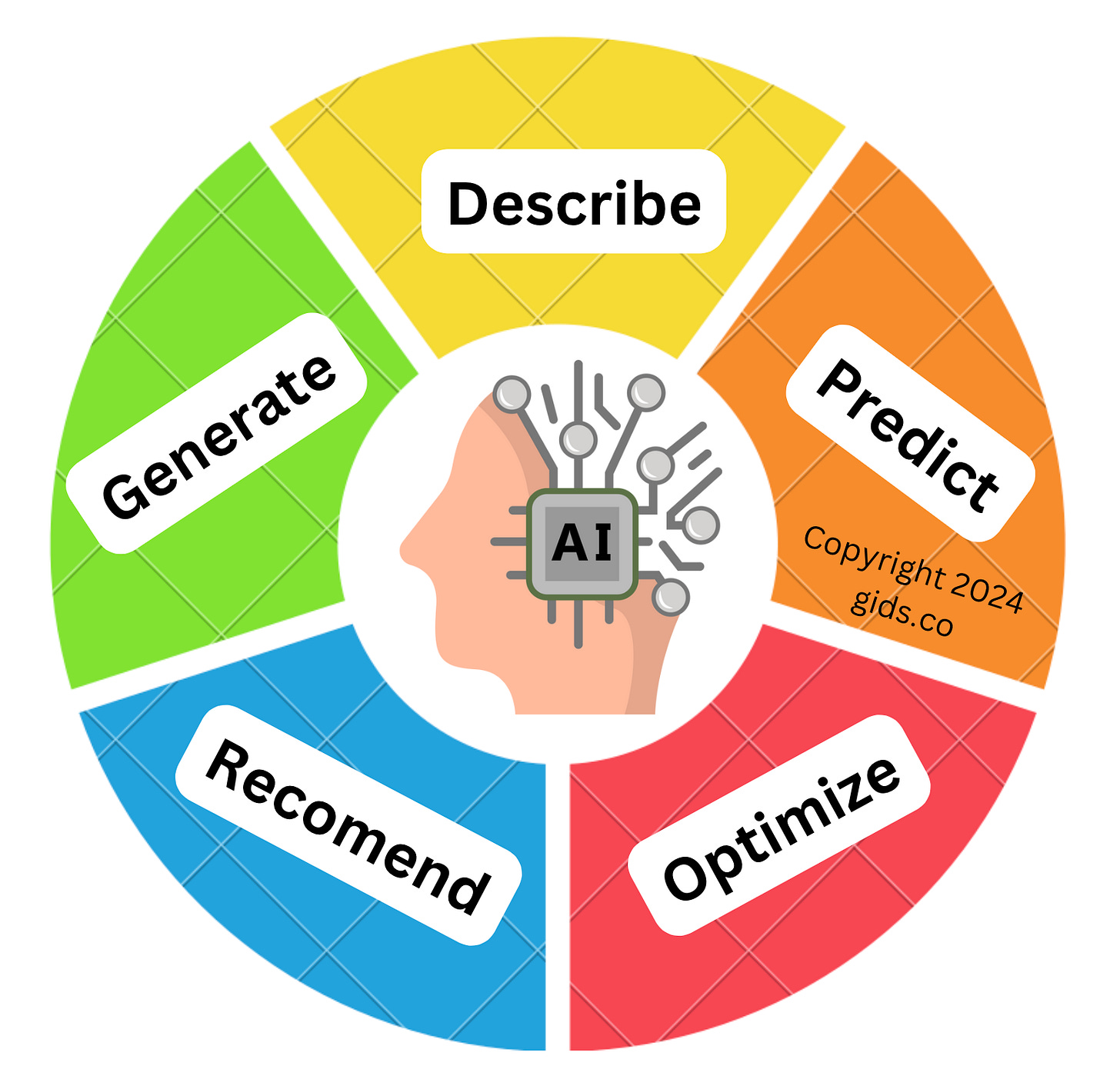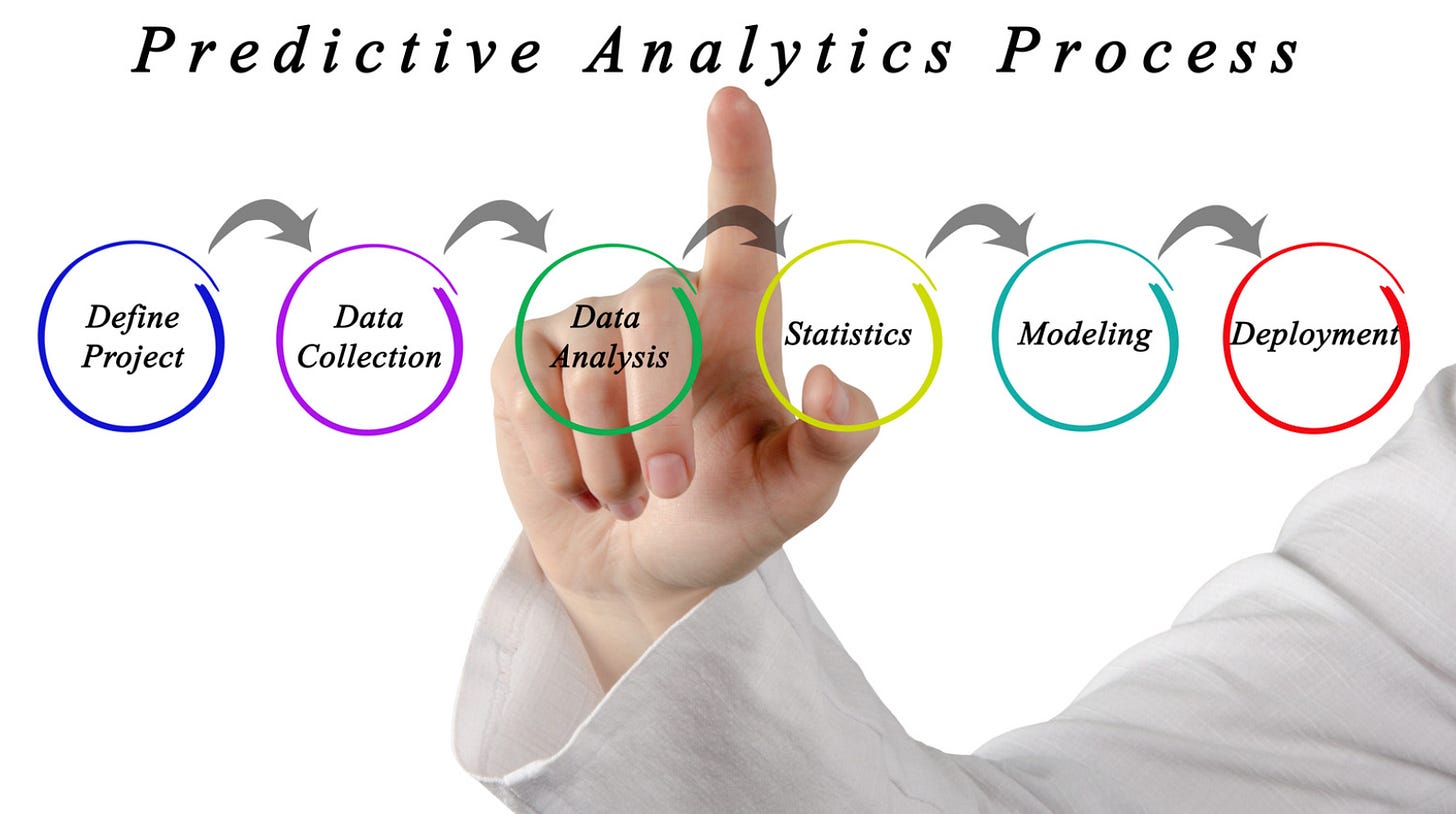The Five Key Approaches to Artificial Intelligence
Describe, Predict, Optimize, Recommend, and Generate
Artificial Intelligence (AI) encompasses various techniques and algorithms that enable machines to perform tasks that typically require human-like intelligence. These techniques can be broadly categorized into five main methods: Describe, Predict, Optimize, Recommend, and Generate. Each technique serves a specific purpose and utilizes different approaches to solve complex problems and make intelligent data-based decisions.
DESCRIBE
Unsupervised Learning, a fundamental approach within the "Describe" method of Artificial Intelligence, focuses on discovering hidden patterns, structures, and relationships in unlabeled data without prior knowledge of the desired output. By analyzing large datasets, unsupervised learning algorithms can identify inherent groupings or clusters of similar data points, detect anomalies or outliers that deviate from the norm, and uncover latent variables or features that capture the essential characteristics of the data. This approach enables AI systems to gain insights and make sense of complex, unstructured information, such as customer segmentation in marketing, image and video analysis, or topic modeling in natural language processing. Unsupervised refers to lacking a target, goal, or objective, i.e., describe.
PREDICT
Supervised Learning, an essential approach within the "Predict" method of Artificial Intelligence, involves training algorithms on labeled data, where the desired output is known in advance. By learning from a set of input-output pairs, the algorithm builds a model that can map new, unseen inputs to their corresponding outputs or predictions. This approach is commonly used in tasks such as forecasting sales volumes, predicting customer churn, or classifying images into predefined categories. Supervised refers to a target, goal, or objective, i.e., prediction, and the input data in isolation is also Unsupervised Learning data.
OPTIMIZE
Optimization, a crucial approach within Artificial Intelligence and Machine Learning, focuses on finding the best solution or set of parameters that maximize or minimize a specified objective function while satisfying given constraints. In the context of AI and ML, optimization algorithms are used to tune the internal parameters of models, such as the weights of a neural network, to improve their performance and generalization ability. These algorithms iteratively search the space of possible solutions, guided by the objective function and the constraints, to find the optimal configuration that yields the best results on the training data and unseen test data.
RECOMMEND
Reinforcement Learning with Recommendation Engines, a critical approach within the "Recommend" method of Artificial Intelligence, aims to provide personalized suggestions or recommendations to users based on their preferences, behaviors, and interactions with a system. These systems learn from historical data, such as user ratings, purchase history, or browsing patterns, and employ reinforcement learning algorithms to identify patterns and similarities among users and items. Reinforcement learning can be defined as encouraging a behavior pattern, and historically, it comes from the behavioral psychology of reinforcement theory.
GENERATE
Generative Artificial Intelligence, the fifth key approach, focuses on creating new data points, such as images, text, or music, that closely resemble the patterns and characteristics learned from the training data. This approach combines the predictive power of supervised learning, which learns from labeled examples, with the descriptive capabilities of unsupervised learning, which discovers hidden structures and relationships in the data. These generated outputs can be further refined and optimized using reinforcement learning algorithms, which provide feedback and rewards based on the quality and relevance of the generated samples. The term "Generative" highlights these AI models' creative and productive aspects, as they can generate new content and expand upon the knowledge gained from the training data.
CAVEAT
It is important to note that Natural Language Processing (NLP) is not directly one of the five key approaches of Artificial Intelligence: Describe, Predict, Optimize, Recommend, and Generate. However, NLP techniques and models, including Large Language Models, can perform tasks that align with the five key approaches, such as describing the sentiment or topics in text data, predicting the next word in a sentence, optimizing language models for better performance, recommending relevant documents or answers based on a user's query, and generating human-like text or dialogue. Natural Language Processing can be defined as using algorithms and computation to derive meaning from human language data.
Check out our Individual AI Accelerator, AI Incubator for Corporate Team Training, or our webinar to learn more.
By John Thomas Foxworthy
M.S. in Data Science from a Top Ten University w/ a 3.80 GPA or the top 5%
Veteran Data Scientist with his first Data Science Model in 2005
Freelance Artificial Intelligence Consultant for a Start-Up as of February 2024
Deep Learning Artificial Intelligence Instructor at UCSD Extended Studies
Master Instructor at Caltech’s Center for Technology & Management Education for Artificial Intelligence, Deep Learning, and Machine Learning








